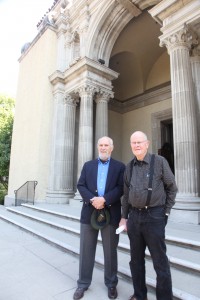I’ve thought on and off about this topic for many years – is there really anything fresh or interesting in art and is there any room in the existing infrastructure for a free-flow of ideas that might, in fact, encourage a real change or real inspiration within the fine art community? The reason I’m thinking about this today is because of a lecture I attended yesterday at Pomona College given by Thomas Crow and followed by a discussion between Mowry Baden and Hal Glicksman. The ideas all three expressed and the re-telling of the particular period in art history (California in the late 1960s) were inspiring and yet also disheartening.
Baden and Glicksman were a part of an inspirational art department at Pomona College that inspired many wonderful adventurous artists who have become more or less well known in the latter 20th century. They told a story of a gallery run by the art department that embraced a young and untested preparator, who happened to be well involved with many local artists, as curator. Hal Glicksman went on to create programming that bent rules and pushed boundaries, he brought in friends and artists whose work he had seen, telling them he would make it work and supported by (or at least presumably not deterred by) the greater institution for which he was working. Crow, now a preeminent art historian but then a college student observing this movement first-hand, offered his own perspective in his lecture. He told the story of artistic give-and-take, of a group of–if not collaborators–friends, and colleagues at all different levels of accomplishment, experience, and technical proficiency. I loved the story for its focus on how ideas are spread – how artists inspire one another when you take out the financial and historical implications of the work.
Unfortunately the story is also disheartening because I just can’t see how this kind of cross-disciplinary/boundary/border/institutional/academic sharing of knowledge, excitement, and experience can happen in today’s world. In the last few years several exhibitions have been mounted that have explored groups of working artists who inspired and interacted professionally as well as personally and who, for the interaction, grew to a level of accomplishment none would have achieved working alone. In particular I think of “Semina Culture” presented by the Santa Monica Museum of Art and exploring the work and circle of Wallace Berman and his circle and the exhibition “Alfred Stieglitz and His Circle” exploring the group of moderns supported, shown, and surrounding Alfred Stieglitz in early 20th Century New York. Art History is, in-fact, full with stories of artist groups and circles who corresponded and collaborated on work in their time. Why is this impossible today?
Financial strain in the art world is real. The pressure on artists to support the financial and developmental mission of any gallery or cultural institution that embraces their work is substantial. For museums and institutions, the need to utilize their long-sought and dearly purchased collections is a primary factor in creating programming. In art schools, especially in Master’s degree programs, the opportunity for cross-development and germination of ideas among artists is possible but the hierarchical structure of the university, the brevity of the programs and subsequent moving away and on of the artist/students, and the lack of support for display and continuation of the outcomes of these ideas, leads to a true stagnation in artistic innovation. The Pomona College we heard about in this lecture was anything but – teachers, undergrads, graduate students, and local artists were joined together in the discussion, they saw each other not as competition, not as higher-ups and lower-downs, not as segways to a successful career, but rather as collaborators in an atelier of ideas.
The closest thing I am seeing today to this kind of innovation and public germination is in the street art and outsider art movements that are now again being embraced by the art community. Unfortunately, with the adoption by cultural institutions, like MOCA in Los Angeles with their “Art in the Streets” exhibition, comes a growing commodification and classification of the movement that defies the impulse for collaboration and free art. This kind of freedom is not, and may never again, however, be able to spring from the established fine art system (educational and institutional).
Despite the fact that we all are so much closer to one another with digital technology allowing us to “friend” and “tweet” at people working on similar projects half-way across the globe, we artists are really growing farther and farther away from each other. Perhaps it is just that I’m too close and too far away to see the movements and collaborations, maybe the Thomas Crow of the 22nd century will discover our generation’s circles of innovators, but from where I’m sitting I have to say, I’m not seeing it.
free art.
